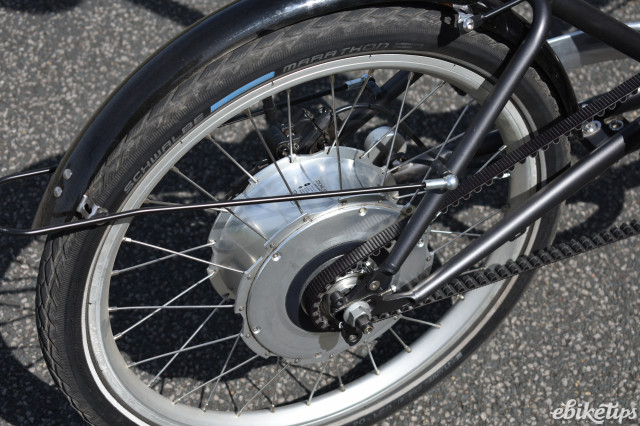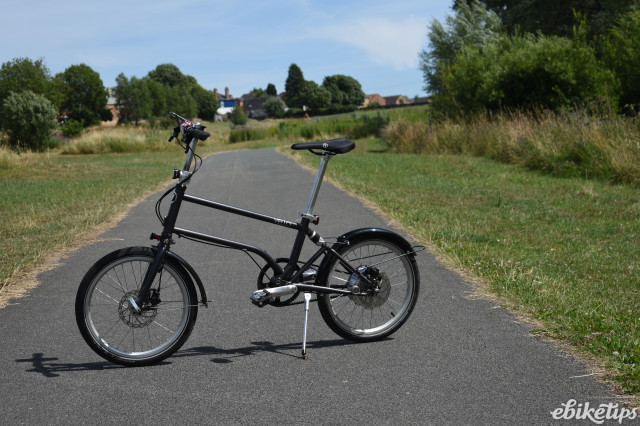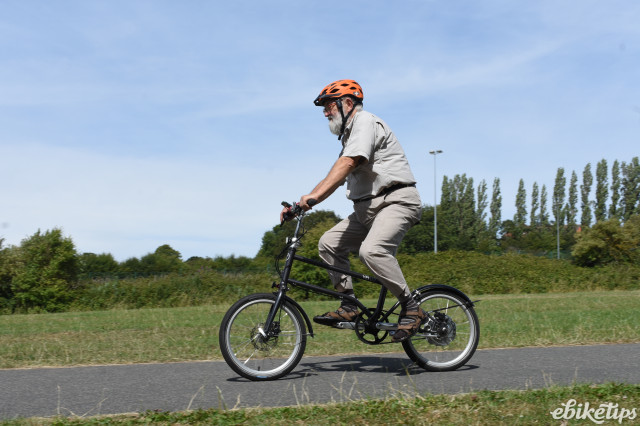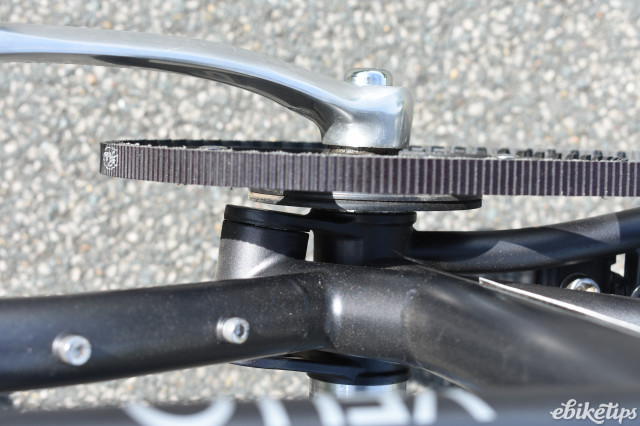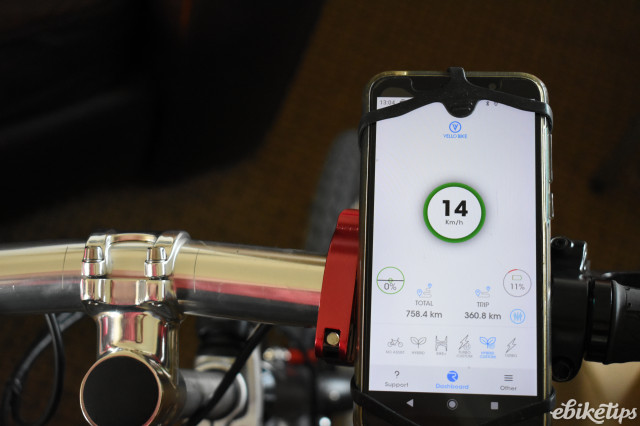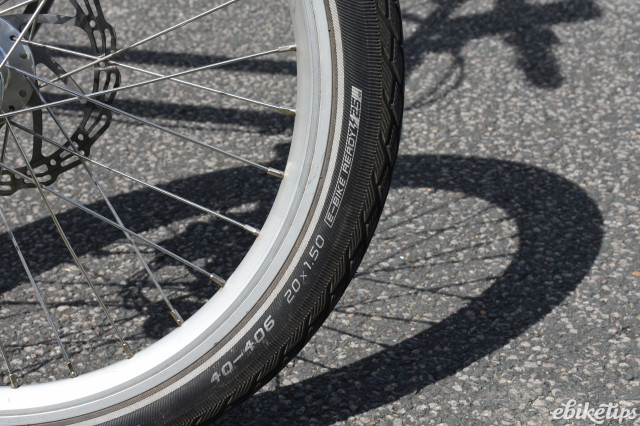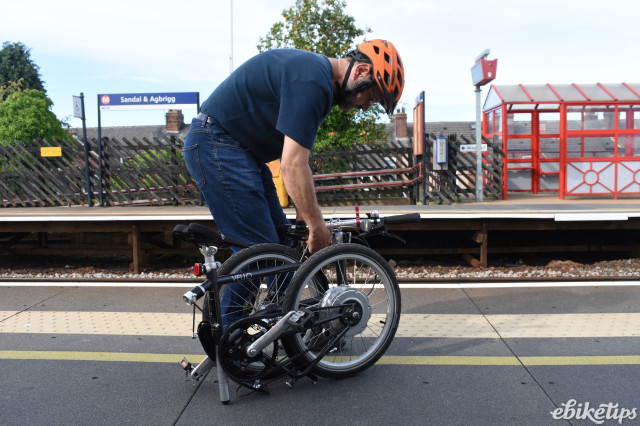
[ad_1]
VELLO is an Austrian-based designer and manufacturer of folding bikes and e-bikes. All of their models are based around 20″ diameter wheels and a frame that boasts a clever ‘tri-fold’ as well as incorporating elastomer suspension. In the UK they are distributed by London-based About the Bike.
They offer steel and titanium frames for both their regular and electric variants. Our test bike came with the steel frame and the optional Schlumpf Mountain Drive gearing (two gears housed in the bottom bracket, changed by tapping your heel on the push button in the base of the crank… ingenious).
There are plenty of single speed e-bikes around at the moment but very few electric folders with belt drives. Carbo is the only one that springs to mind. Like the VELLO it claims the tag of world’s lightest electric folding bike at around 13kg but the Hummingbird’s 10.9kg (as measured by us) is still streets ahead of all the others. Our test VELLO weighed 16.4kg but without the Schlumpf Mountain Drive it would have certainly been at least a few hundred grams lighter. For a 20″ wheeled, steel-framed folder this is a respectable rather than jaw-dropping weight. If you think it’s too much for you, there is also a titanium version that will be significantly lighter (but retails at £4,190). The claimed weight for that one is 12.9kg.
First impressions are of a high quality bike. The Cro-Mo steel frame is neatly welded and the own brand VELLO hydraulic disc brakes also look the part. Schwalbe Marathon 20″ x 1.5″ tyres are designed to give good road speed but are also capable on easy-to-ride unsealed surfaces. The test bike also came with third party rechargeable Moon Orion lights and VELLO have cleverly incorporated secure-turn magnetic fittings into the seatpost clamp and handlebar stem quick release fitting so the lights can be put on and off in an instant. There’s plenty of height adjustment in the handlebar stem and seatpost, so the Bike+ should suit a wide range of rider sizes.
There’s also plenty of proprietary technology on the VELLO Bike+, from the rear elastomer suspension block (that doubles as a magnet to hold the hinged rear triangle to the main frame) to the hinged front fork that also features a magnet and hook fixing (working in concert, these two elements keep the whole folded package together). The offset frame hinge also manages to keep the belt drive in tension for the fold, meaning there is no need for any kind of separate tensioning mechanism which would add weight and complication. It looks a nice combination of design minimalism and practicality.
Ebiketips have looked at the ‘all-in-one’ Zehus motor system used by VELLO before, in the shape of the Hummingbird Electric and the Quella Electric Varsity. The big news with the VELLO though is that whilst its Zehus motor keeps the same shiny large rear hub that contains all the e-bike drive components – battery included – it has numerous improvements, including a 20% bigger battery (now 173Wh) and more torque, plus a much more reliable Bluetooth connection to the handy Bitride app. It retains regenerative braking and a built-in inclinometer to measure gradient. We felt the new version was a much more capable performer than its predecessor after our road test…
On the road
On our standard hill test the VELLO was only just behind some of the smallest geared hub motors we have tried like the Cowboy 4ST and the MiRider 2021. For a direct drive motor, that’s pretty impressive. Although the Zehus hub might appear big and powerful, remember there’s a 173Wh battery, controller and various sensors in there too, so not that much space for a motor.
Power delivery is lovely and smooth and responsive to pedalling. It feels like it has a torque sensor though apparently it’s all done with algorithms based on the input from speed and gradient sensors. The fact that the bike itself feels rigid and responsive to ride also means you want to stand out of the saddle on it and move quickly. It just has that go-fast ride position and feel to it – though there is the option of a higher handlebar stem for those who like a more upright riding position.
And although it wasn’t the out and out quickest on the hill test or during our range test (the latter involving plenty of 10% plus gradients and even some 15% plus ones), there was never a hill that defeated the motor. Like any electric single speed, it required a bit more human input than multi-geared e-bikes, but even on the steeper hills this moderately fit test rider was only ever mildly out of breath.
Only on the occasional 20%+ gradient was it necessary to use the Mountain Drive. Click the crank button with your heel and you have an ultra low gear. This provided the option of ambling up the steepest of slopes at 7-8mph. It’s only here, at very low speed, that the motor is really audible. Most of the time it’s just a quiet hum in the background.
Range in Hybrid Custom mode, set to max power and max regen braking (see below), returned a range of 23 miles over very hilly terrain. For a direct drive motor with a pretty small battery, that’s a remarkably efficient e-bike, coming in at well under 10Wh per mile. Of course this figure can vary massively depending on rider weight, weather, power mode, terrain and a whole host of other factors.
The Gates belt drive proved faultless and is a great, low maintenance feature. No oil needed and cleaning is as simple as sloshing some water over it.
Apps and riding modes
Whilst there is an optional wireless remote handlebar unit through which you can control riding modes, the most reliable way of doing so is via the excellent Bitride app. Unlike the first version of the Zehus system we tested, the Bluetooth connection proved 100% reliable.
The way the riding modes are named is a little confusing but the actual combinations proved quite useful in test riding. They are listed here in order of how useful we found them. Unlike most e-bikes systems where you just dial up and down the power, the Zehus app settings let you decide to what extent you let the inclinometer automatically determine how much power and regen is applied.
Hybrid and Hybrid Custom – The motor helps you when you ride at lower speeds and up steep hills but attempts to recover energy at higher constant speed and down steeper hills. Hybrid power mode is sensitive to the road slope. The Hybrid Custom mode (which allows you to set assistance and regen to maximum) fitted in with our test riding style over hilly terrain. We got the most assistance possible up hills and when accelerating – the situations when power is most useful – and it tailed off at higher speeds with a small amount of regen applied sometimes. On steeper, faster descents full regen is applied, slowing you down and feeding a small amount of power back into the battery. All in all, it felt both natural to ride and an efficient use of the automatic sensing functions of the motor and the regen.
Turbo and Turbo Custom – If you don’t want the system to automatically compensate for gradients but just want max power when you turn the pedals forward (or max regen when turning them back) then this is the mode for you. It’s designed to get you where you are going ASAP when you are confident you have enough battery capacity to get there. Again, the Custom option lets you fine tune the level of assist and regen and also the max assisted speed up to the legal limit of 15.5mph. It’s also a useful mode in situations where the automated Hybrid modes cannot detect some factors that need more power, such as into strong headwinds.
Bike + – To quote the VELLO manual, “BIKE + mode changes the motor map automatically and continuously in order to keep the battery charged. The motor assistance and the cutoff speed both depend on the battery charge, the input from the pedals (speed-torque) and the road slope. In this power mode you never need to charge the batteries.”
While this sounds like an almost magical, perpetual motion mode that will keep the batteries charged up, in practice it just felt as if it were slowing the rider down or not giving enough assistance – especially when the battery level started to deplete. Far easier to spend a few pence on a full charge from the electric socket and use another mode that will let the motor do more of the work for you.
The fold
Folding the VELLO is a pretty quick and easy affair once you have the technique. Like the Brompton, it’s mainly a case of having the pedal cranks in the correct position before you start and doing things in the correct order whilst standing on the correct side of the bike. It’s a pain to remember the relatively simple order of things at first, but I suspect many regular folding commuters actually enjoy showing off just how quickly they can fold up their bike once they have it down to a fine art.
It’s a ‘tri-fold’ design so folding involves undoing the fork clamp and whipping out the ball lock pin before lifting the bike and (now comes the slightly skilful bit) letting the front wheel swing to the non-drive side whilst knocking the rear triangle free of its magnet fixing so that can swing alongside the front wheel. Then just latch the hook on the front wheel over the bottom main frame member and a magnet also clicks into place here. Drop the seat and the bars and you’re done. Well, almost, as if you want an even smaller folded package the bars split half way along thanks to quick release cams. If may sound a bit complicated, but with practice it really isn’t. If you are happy with a Brompton fold, you’ll be happy with a VELLO fold.
We did a direct timed fold and unfold comparison between a Brompton and the VELLO and whilst the VELLO was slower, it wasn’t by that much – and no doubt the VELLO’s time would get quicker with practice as the test was carried out by an experienced Brompton user. If rushing to get on a train, a VELLO fold-down should take less than a minute or even half a minute for the slick and experienced.
Our measurements gave a folded package size of around 81 x 37 x 57cm – a bit bigger than VELLO’s quoted folded size. Still, it’s a reasonably neat and well-balanced package to carry around and the hook and magnet combination keeps everything well-locked together. It’s also worth noting that the drive-side folding pedal sticks out quite a way and if replaced with a removable pedal (as made by MKS for example) it’s easily possible to trim a few cm off the folded width).
The two tyres, seatpost and crank arm make four points of contact with the ground so the whole thing stands upright well. The bike was actually personally delivered by UK distributor About the Bike by intercity train, and apparently it fitted snugly in the handy space behind the seat.
Whilst clearly not as small as the Brompton fold, it’s a pretty impressive feat for a 20″ folder and its relatively light weight really does mean it’s a realistic choice for a regular e-bike-train commuter using busy trains. Not too many electric folders genuinely come into that bracket, being either too heavy or too big/ungainly when folded – or both.
Competitors
The ‘base’ price of the VELLO is £2,990 which looks a little pricey against the lightweight, single speed £2,499 Flit-16 (which also includes lights) but puts it in the same league as the £2,995 Brompton (though that also includes lights and mudguards and has six gears).
Both the above initially look better value but use 16″ wheels and the VELLO gives a more surefooted ride through the use of the larger wheels.
After a recent £500 price cut, the Gocycle G4 is now £3,299 and so firmly in the VELLO Bike+’s orbit (the G4 also now comes with lights and mudguards as standard). The VELLO Bike+ may not have the outstanding front hub motor of the Gocycle – after all it’s one of the best if not the best hub motors we have tried – but the VELLO is lighter by around 1.75kg and simpler and easier to use and folds up smaller.
The most obvious competitor though is the Hummingbird Electric which we tested back in 2019. It also uses the Zehus system, though our test model used the previous, less powerful iteration. The Hummingbird is lighter and folds more quickly, but it’s over a metre long and has an eye-watering current price of £4,495. Unless weight is critical the VELLO+ does much the same thing (you get exactly the same motor technology) for £1,500 less and with the benefit of the larger wheel size.
The RRP of the Schlumpf speed drive (or Mountain drive) is £400 but so ultra-low is the gear ratio that it is only really advisable for those who live in really, really hilly areas. Whatever e-folder you might be tempted by, the fact remains that a really capable, viable train commuting train e-folder will cost several thousand pounds. But such bikes tend to hold their value well and consider what you might save on other forms of transport – for example, avoiding last mile(s) tube or taxi fares. In essence, a good quality electric folder like the VELLO is a highly practical and money saving tool as well as a nifty bit of design.
In short, the VELLO Bike+ gives a super smooth and super simple ride. There’s also a wealth of clever motor tech and power delivery going on underneath the surface that makes it one of the most efficient e-bikes we’ve tried.
[ad_2]
Source link

